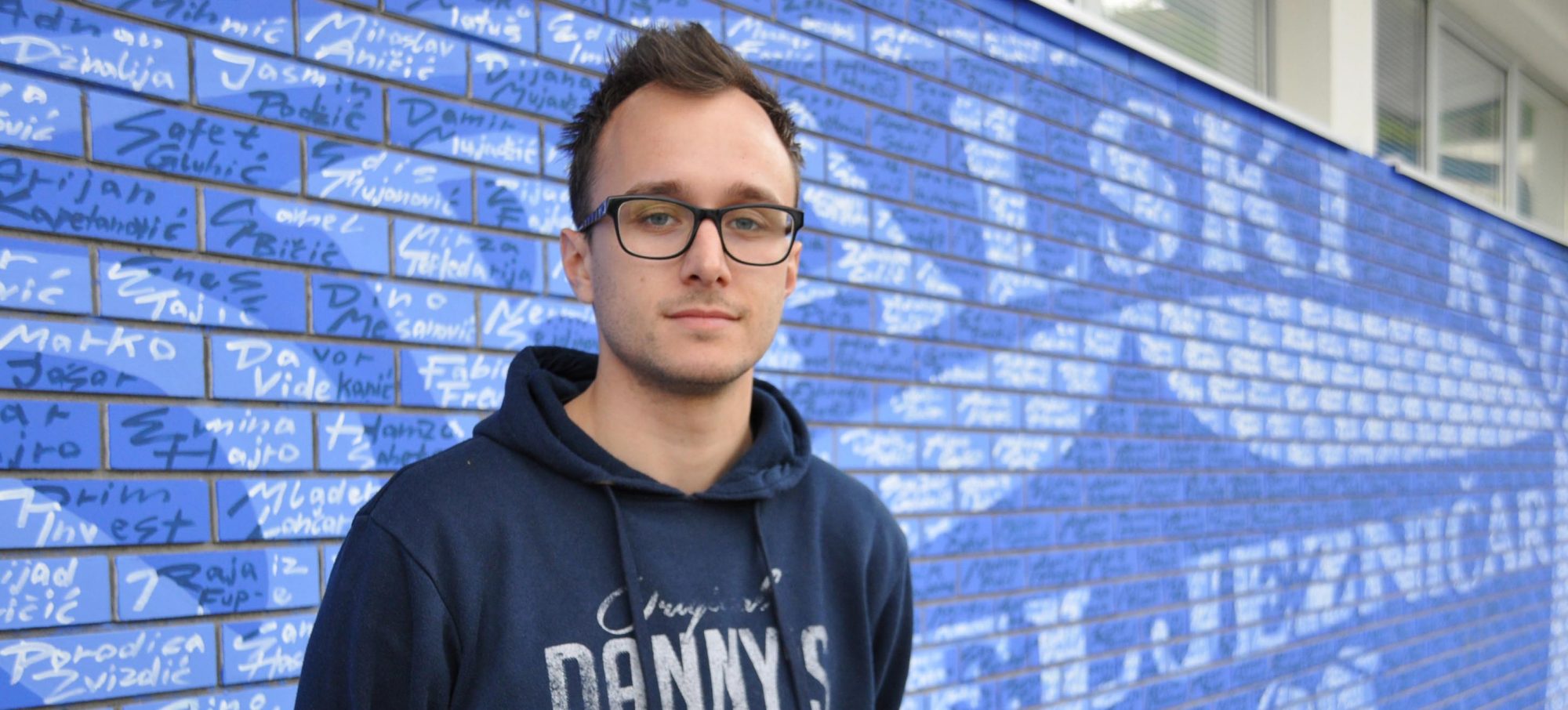Grbavica, home of FK Željezničar, is like a synonym for the darkest period in the history of Sarajevo. For Emir Muhamedagić the neighborhood is also place of hope.
Emir Muhamedagić is standing on the balcony of his family apartment, turns his head to the right and points across the street. „When I grew up here I sometimes looked right into the stadium and watched the score on the scoreboard.“ When the 26-year-old talks about his love for football his eyes move fast with excitement, memories drop from the top of his head like raindrops and the dream is still there: the dream of a boy to celebrate a game winning goal for his club FK Željezničar Sarajevo. But today Emir no longer wears the jersey of his team on the pitch to make his dream come true. He followed another path to help his club move forward in a community that is still struggling with the aftermath of the recent war.
„When we moved here in 1996 the damage done by the war was still very present. The players could not even enter the pitch as they assumed that there were land mines hidden in the ground,“ says Emir. Grbavica, the name of Željezničar’s stadium and the neighborhood, marked the frontline during the siege of Sarajevo and was the only part of the city occupied by the Serbian paramilitary forces. The apartment building Emir and his family moved in one year after the war was barely inhabitable at the time. „The front part almost came down and there were holes through which the Serbian forces were crossing from one apartment to the next.“
VIDEO: Emir about his childhood in Grbavica and the role of FK Željezničar for the neighborhood.
20 years after the war Grbavica is more than just a neighborhood in Sarajevo. It is a pseudonym for the darkest period in the history of the city. Veselin Vlahovic and his paramilitary forces ragged here. The so-called „Monster of Grbavica“ has been recently convicted to 45 years of prison because of crimes against humanity. There are still hundreds of bullet holes all over the many apartment blocks of the neighborhood.
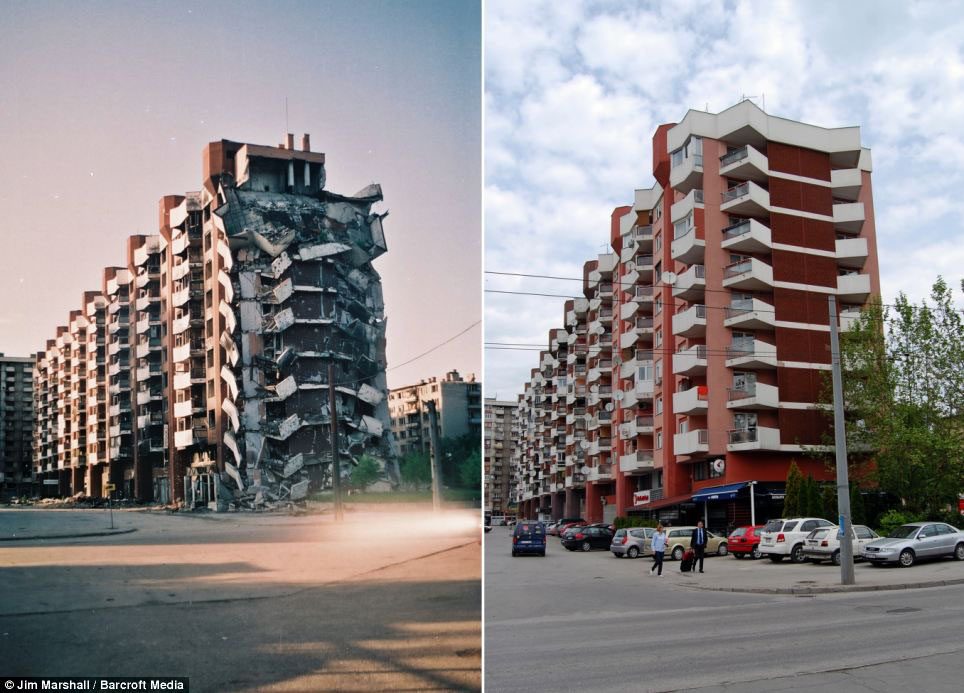 The apartment building Emir lives in right after the war and today
The apartment building Emir lives in right after the war and today
But for Emir Grbavica has always been his home and a place of hope. „When the first derby Željezničar against FK Sarajevo was played in the stadium after the war it was like people were reborn. The match symbolised that we are still alive: the people, the city, and the derby,“ Emir adds. For the 26-year-old Grbavica is his childhood memories, daily life with his mother and two brothers and the home of his dream. And the stadium is the living room of the neighborhood where people meet and get together.
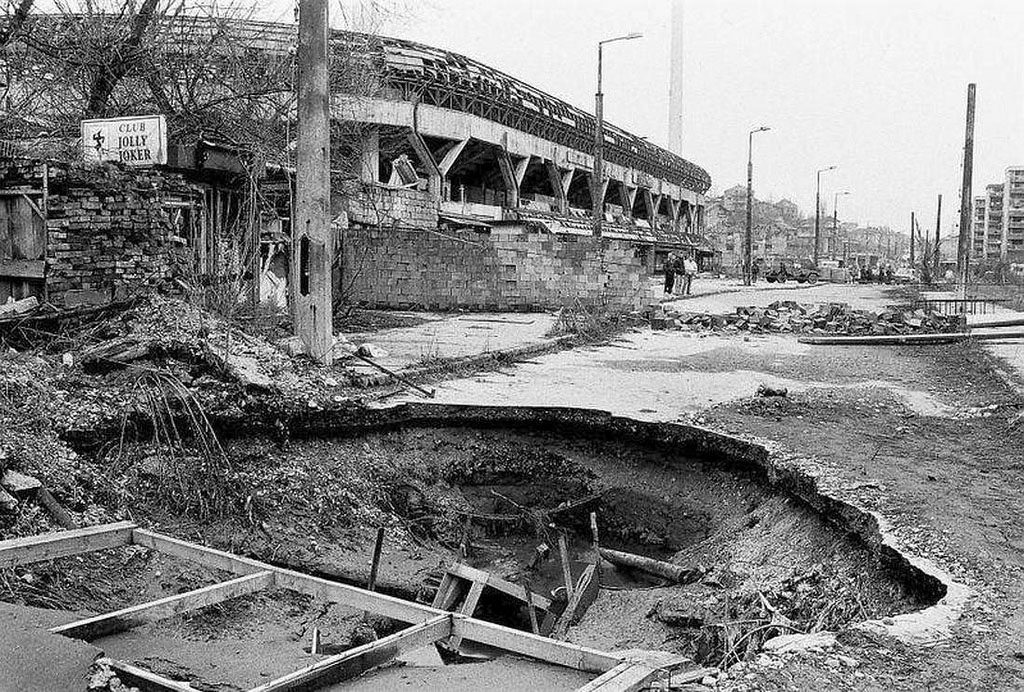 The stadium after the war
The stadium after the war
Emir was six years old when he joined the youth squad of Željezničar. In the summer months he and his friends met on the small football ground next to his school close to the stadium. „We played there until it was dark. Right next to the school was a church with a clock. That clock told me when I had to leave because I always had to be home at 9pm.“ Over the years he saw how Grbavica slowly recovered. The stadium, once proud host of European games with 25,000 specators, got rebuilt step by step.
Meanwhile Emir’s dream on the pitch ended. When he was 19 years old he realised that his skills on the football ground did not match his passion for the club. He quit, but came back three years later helping to give Željezničar a modern look. On the pitch the club did well winning three championships in four years (2010, 2012, 2013). But the infrastructure of the club was in a bad condition. „We were all fans and young guys educated in marketing, video production, design, IT and public relations. About 15 of us offered our services to the club free of charge.“ Emir took care of public relations. „It was exciting to work for the club I grew up with. There was a hype about helping the club grow, especially in reconstructing the stadium. We had a feeling that we can do this together.“
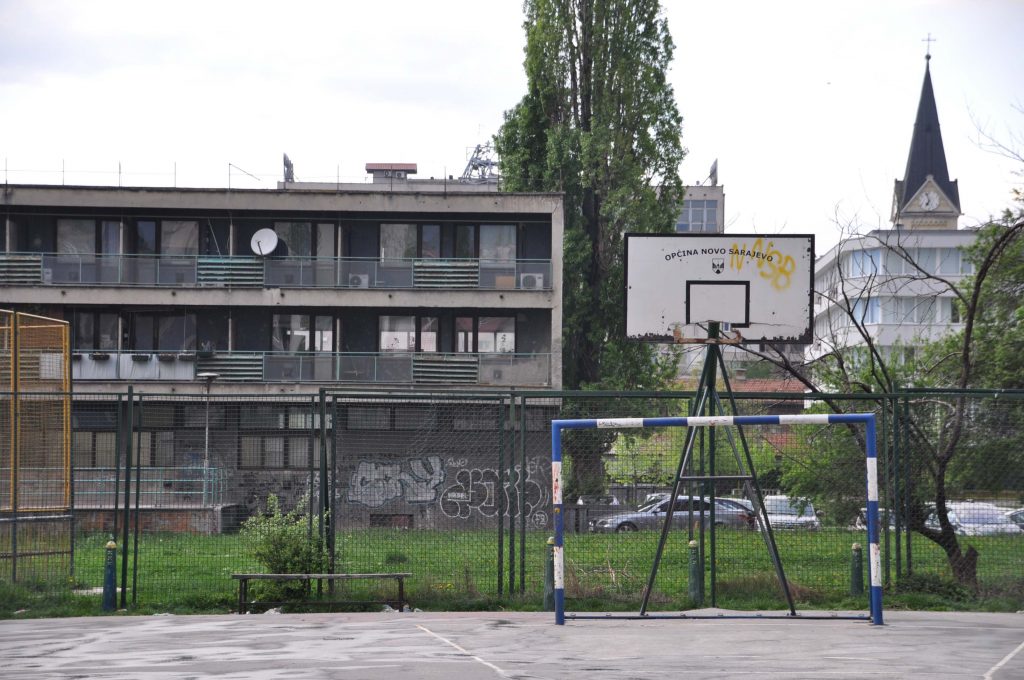
„I always had to be home at 9pm“ The church clock from Emir’s youth
At this time in early 2013 Željezničar was not able to play European qualification games at Gbravica because it did not meet UEFA standards. The club started a crowdfunding campaign called “Buy a Seat for Grbavica”. Emir and his fellow fans took care of public relations and marketing of the campaign“. Every Sunday they published the amount of money that had been raised and what it was used for on the club’s website. The campaign raised around 150,000 Euros. Emir is certain: „This kind of transparency was unseen before in Bosnian football.“ They also published every fan and sponsor who donated money on the club’s facebook page. „People shared our posts because they were excited to be associated with the club. That helped a lot in getting attention for the campaign.”
When the 26-year-old is talking about the effort he, his friends, the fans and the club put into „Buy a Seat for Grbavica“ he sounds like he is telling the story of an important game Željezničar had to play. The moment when the team got together and walked onto the pitch, the first couple of minutes needed to gain confidence, the obstacles the players had to overcome and the smiling faces once their team scored a goal.

Emir and Željezničar’s head of the youth academy Sejfudin Tica
But the game and the work were not over yet. In fact, it was just half time. And the second half was no piece of cake either. The entire East Stand of the stadium needed to be rebuilt from scratch. A new campaign called „European Grbavica“ was brought to life. Fans could literally buy a seat. For 500 Euros, more than the average monthly income in Bosnia, fans and sponsors could buy a seat on the East Stand and watch all games played at Grbavica for the next 10 years. „I didn’t think the campaign could be successful because 500 Euros is a lot of money in Bosnia. But it worked. Even my older brother bought a seat.“ „European Grbavica“ raised around 350,000 Euros. The new East Stand was opened by Ivica Osim, the club’s most prominent player and coach, in spring this year. Emir was there, on the stand, with his friends. But at the time he did not work for Željezničar anymore. After four years of working for the club besides his regular job at a public relations agency time was short and Emir left the club in early 2017.
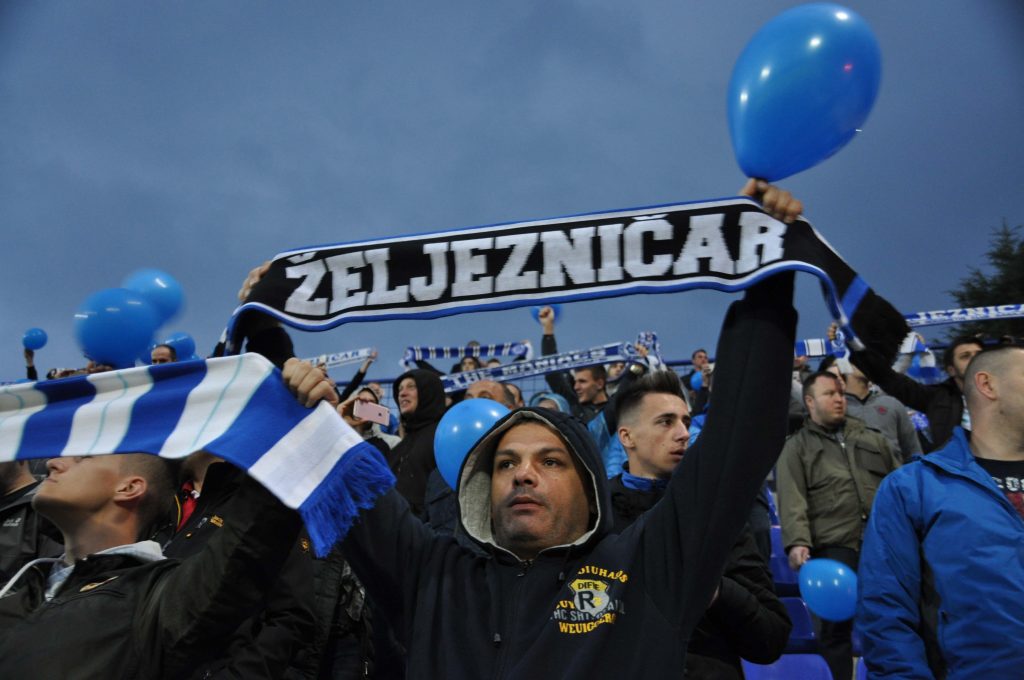
„European Grbavica“ The East Stand as the latest piece in reconstructing the stadium
But he did not give up his dream. „When I left Željezničar I wrote an email to all players reminding them that they have the privilege to play for this club and live the dream for many of us. They should never forget that they are doing something that can make people happy. And that is beautiful.“
Back on the balcony Emir is chitchating with his uncle who is parking his car in front of the apartment building. Right across the street the stadium emerges like a constant reminder of Emir’s dream. The dream to celebrate a game winning goal for his club. Be it as a player in the youth squad, as the club’s press officer or as a fan on the East Stand.
The club: FK Željezničar Sarajevo
Founded in 1921 by railroad workers, the club won the Yugoslavian Championship in 1972. Zeljo – as the club is often called – was known for their attractive kind of play lead by the “Strauss of Grbavica” Ivica Osim. Although winning the championship in Bosnia six times in the last 20 years, the club has failed to qualify for any European competition since the end of the war. At the beginning of the 2017/18 season Zeljo played UEFA Europa League qualifications again at Grbavica but lost in the second round against the Swedish club AIK. Plans are currently examined to finish the reconstruction of the stadium in the next coiple of years making Grbavica a modern 20,000 capacity arena.
The city: Sarajevo
During the 1980s the city known for its religious and cultural diversity experienced a decade filled with exciting sporting events, flourishing art scenes and a vibrant urban life. But the war brought this development to an abrupt end only a few years later. During the siege of the city, 11,541 people lost their lives, including over 1,500 children. An additional 56,000 people were wounded. Today, the capital of Bosnia and Herzegowina is slowly recovering and has a population of about 275,000.
The country: Bosnia and Herzegovina
The country declared independence from Yugoslavia on March 3, 1992. The following war killed more than 100,000 people and was ended with the Dayton agreement on December 14, 1995. Since then economic and political progress has been slow. Since the end of the war approximately 150,000 young Bosnians have left the country, and around 10,000 young people still leave the country each year.
In 2016 the unemployment rate was about 25 percent. Youth unemployment was even higher than 65 percent. Bosnia has a population of approximately 3,5 million people with an average salary of around 400 Euro. The political system of the country, which has been based on ethnic identity since the war, is considered to be one of the world’s most complicated systems of government.
Recommendations
Grbavica (film). Grbavica is a 2006 film by Jasmila Žbanić about the life of a single mother in contemporary Sarajevo in the aftermath of systematic rapes of Bosniak women by Serbian soldiers during the Bosnian War.It won the Golden Bear at the Berlin International Film Festival in 2006 and was Bosnia and Herzegovina’s official entry for the Best Foreign Language Film at the Oscars that same year.
The Game of His Life: A Biography about Ivica Osim. The book about Željezničar’s legendary player and coach by Marko Tomas is a wonderful, insightful and funny personal and general history of Sarajevo, the club, Yugoslavia and Bosnia in the 20th and early 21st century.
Grbavica (song). The song by the Bosnian singer Tifa is the official club’s anthem sung before every home game. In the 1980s Tifa was also briefly the singer of Sarajevo’s legendayr rock band Bijelo Dugme.
